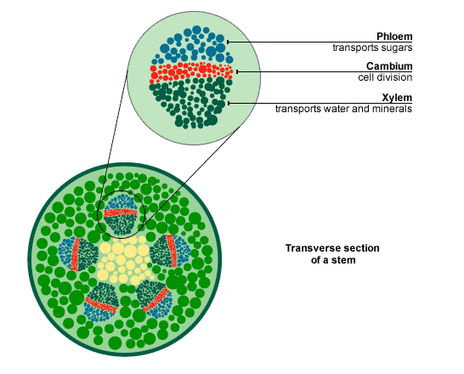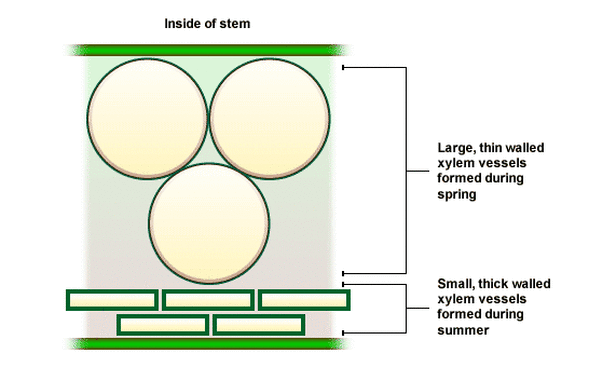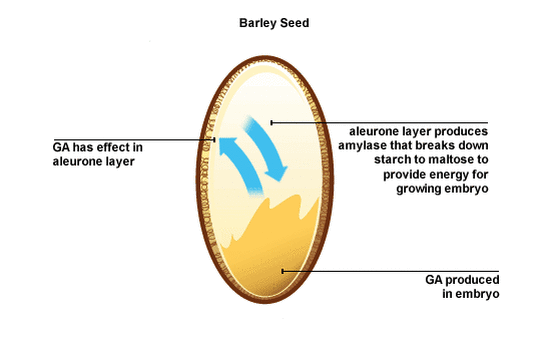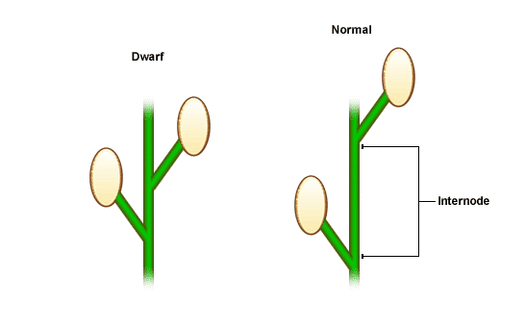Growth
Growth is defined as the irreversible increase in the dry mass of an organism. It is brought about by an increase in cell size or number.
In plants, growth occurs throughout the lifetime of the plant. Plant growing points are known as meristems and can be found at the tip (apex) of roots and shoots, or in between the xylem and phloem (cambium).
Growth is defined as the irreversible increase in the dry mass of an organism. It is brought about by an increase in cell size or number.
In plants, growth occurs throughout the lifetime of the plant. Plant growing points are known as meristems and can be found at the tip (apex) of roots and shoots, or in between the xylem and phloem (cambium).
Growth within the cambium is responsible for the development of annual rings. The cambium cells divide to form new xylem to the inside and some phloem to the outside. It is the xylem cells that form the rings. In spring the vessels are wide in diameter with thin walls, whilst in the summer/autumn they are more compact and have thicker walls.
This diagram shows one year's growth.
This diagram shows one year's growth.
Plants have extensive powers of regeneration. They can replace lost or damaged tissue. Whole plants can be grown from small parts of plants such as cuttings or tissue cultures. Growth of new plants or regeneration of parts of plants is dependant on the activity of undifferentiated cells.
Growth in animals occurs all over the body and only until adulthood is reached. Animal regeneration is limited and can occur in only a few tissues. Skin and liver cells, for example, can regenerate after damage.
Growth in animals occurs all over the body and only until adulthood is reached. Animal regeneration is limited and can occur in only a few tissues. Skin and liver cells, for example, can regenerate after damage.
Growth hormones in animals
Hormones are chemical messengers. In animals they are produced in the endocrine glands and released into the bloodstream for transportation to their site of action. In animals the pituitary gland is responsible for the production of many hormones, including the growth hormones somatotrophin and thyroid stimulating hormone (TSH).
Somatotrophin (or Human Growth Hormone) stimulates growth by increasing the uptake of amino acids by cells and promoting the synthesis of proteins. Overproduction in children leads to increased overall growth (gigantism), whilst underproduction leads to reduced overall growth. Overproduction in adults leads to an enlargement of hands, feet and jaw bones.
.

thyroxine
TSH controls the production of thyroxine by the thyroid gland. Thyroxine affects metabolic rate. Overproduction of TSH causes increased size and activity of the thyroid gland. Symptoms include a swollen neck and bulging eyes. Underproduction in children leads to decreased mental and skeletal development, whilst in adults it results in lethargy and increased weight.
Growth in plants
Auxins and Gibberellins are two major hormones that affect the growth of plants. They are effective at low concentrations. They are produced in one area of the plant and transported to other parts where they have an effect.
Auxins, e.g IAA
- Indole Acetic Acid (IAA) is a produced at the growing points – root tips, shoot tips and meristems
- IAA stimulates cell division, elongation and differentiation
- High levels of IAA stimulates shoot growth and inhibits roots growth. This allows IAA to be used as a selective herbicide. It causes the plant shoots of broad-leaved plants to grow so rapidly that it exhausts the plant, whilst having little effect on narrow leaved plants
- Low levels of IAA promote the growth of adventitious roots in cuttings and can therefore be used as a rooting powder
- IAA is destroyed by light and this leads to the phototropic effect (plants moving towards the light). IAA on the side nearest the light is destroyed and therefore the cells do not undergo as much division and elongation, whilst those on the opposite side are experiencing the effects of IAA causing the apparent bending of the plant
- IAA produced in the apical buds can inhibit the growth of lateral (side) buds. Apical dominance can be prevented by removing the apical bud. This allows the side buds to develop and the plant will become bushy.
- IAA produced by developing seeds causes the fruit coat to develop from the ovary wall.
- Low levels of IAA cause the formation of an abscission layer, which leads to leaf drop.
Gibberellic Acid (GA) overcomes dormancy in seeds and buds. It induces the production of -amylase by the aleurone layer in barley seeds.
GA can also be used to grow dwarf plants to normal height. Cell elongation is promoted and the internode length is increased.
Effect of chemicals on growth
Plants
Macro elements are required for normal growth, each element having a different function within the plant.
Water culture experiments are carried out to investigate deficiency symptoms. Each container is set up identically with all nutrients except the one being tested present in the solution. A control containing all the elements is also used. The table below shows the deficiency symptom and the role the macro-element plays in the plant.
Plants
Macro elements are required for normal growth, each element having a different function within the plant.
Water culture experiments are carried out to investigate deficiency symptoms. Each container is set up identically with all nutrients except the one being tested present in the solution. A control containing all the elements is also used. The table below shows the deficiency symptom and the role the macro-element plays in the plant.
Animals
Chemicals can affect the growth of animals by their presence or their absence.
Iron is required for the production of haemaglobin in red blood cells and is also a component in many enzymes and cytochrome.
.
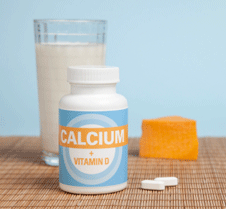
Calcium
Vitamin D
Lead
Drugs
Calcium is necessary for blood clotting, bones, shells and teeth.
Vitamin D is formed in the skin when exposed to sunlight, or obtained from milk in the diet. It is necessary for the uptake of calcium from the intestine. A shortage can lead to bone deformation (rickets).
Lead is harmful and can inhibit the action of some enzymes. It can cause learning difficulties in young children – one of the reasons we now have lead-free petrol.
Drugs such as Thalidomide, nicotine and alcohol can all cross the placenta and effect the developing foetus. Thalidomide, an anti-nausea drug no longer used, can cause limb deformations. Alcohol and nicotine can retard growth and mental development.
Vitamin D is formed in the skin when exposed to sunlight, or obtained from milk in the diet. It is necessary for the uptake of calcium from the intestine. A shortage can lead to bone deformation (rickets).
Lead is harmful and can inhibit the action of some enzymes. It can cause learning difficulties in young children – one of the reasons we now have lead-free petrol.
Drugs such as Thalidomide, nicotine and alcohol can all cross the placenta and effect the developing foetus. Thalidomide, an anti-nausea drug no longer used, can cause limb deformations. Alcohol and nicotine can retard growth and mental development.
Effects of light on growth
Plants
In the absence of light plants will utilise their resources to grow to where they might find light and be able to photosynthesise. They develop a condition called etoilation. This is characterised by small yellow leaves, weak stems and long internodes.
Photoperiodism
Flowering is an example of a photoperiodic response. Light is detected in the leaves. A plant has a critical period of darkness to which it will respond. Short day plants will flower once hours of uninterrupted darkness are above a critical level. They will generally flower in late summer or autumn. Long day plants flower when darkness is below a critical level. Long day plants generally flower in spring or summer.
Animals
Animals are seasonal breeders. Their mating is in response to increasing or decreasing daylength, depending on their gestation period. This ensures that their young are born at a time of year when their survival chances are greater.
Populations and succession
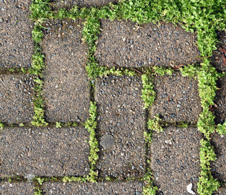
Populations and succession
Plants will quickly colonise an area previously uninhabited. Mosses, lichens and weeds are generally the first plants to start growing, they are known as the pioneer community. There is little diversity, a low biomass and a very simple food web at this stage.
Over time nutrient rich soil will form from the dead plants and broken down rocks. The environment will become less suited to the pioneer community and more suited to other species of plants, such as grasses and shrubs. These intermediate communities will slowly give way to more complex plants and biomass, diversity and the food web will all increase.
Finally the ecosystem becomes stable, a climax community has formed and there is very little further change. This long term development of an environment to a stable and complex ecosystem is called succession.
Over time nutrient rich soil will form from the dead plants and broken down rocks. The environment will become less suited to the pioneer community and more suited to other species of plants, such as grasses and shrubs. These intermediate communities will slowly give way to more complex plants and biomass, diversity and the food web will all increase.
Finally the ecosystem becomes stable, a climax community has formed and there is very little further change. This long term development of an environment to a stable and complex ecosystem is called succession.
